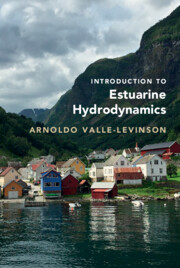Book contents
- Introduction to Estuarine Hydrodynamics
- Introduction to Estuarine Hydrodynamics
- Copyright page
- Contents
- Preface
- 1 Introduction and Classification
- 2 Conservation Equations
- 3 Tides in Semienclosed Basins
- 4 Shallow-Water Tides
- 5 Tidal Residual Flows in Homogeneous, Semienclosed Basins
- 6 Wind-Driven Flows in Homogeneous, Semienclosed Basins
- 7 Flows Driven by Density Gradients
- 8 Interactions among Tides, Density Gradients, and Wind
- 9 Fronts
- 10 Time Scales in Semienclosed Basins
- 11 Semienclosed Basins with Low or No Discharge
- 12 Classification of Semienclosed Basins, Based on Dynamics
- Index
- References
2 - Conservation Equations
Published online by Cambridge University Press: 24 February 2022
- Introduction to Estuarine Hydrodynamics
- Introduction to Estuarine Hydrodynamics
- Copyright page
- Contents
- Preface
- 1 Introduction and Classification
- 2 Conservation Equations
- 3 Tides in Semienclosed Basins
- 4 Shallow-Water Tides
- 5 Tidal Residual Flows in Homogeneous, Semienclosed Basins
- 6 Wind-Driven Flows in Homogeneous, Semienclosed Basins
- 7 Flows Driven by Density Gradients
- 8 Interactions among Tides, Density Gradients, and Wind
- 9 Fronts
- 10 Time Scales in Semienclosed Basins
- 11 Semienclosed Basins with Low or No Discharge
- 12 Classification of Semienclosed Basins, Based on Dynamics
- Index
- References
Summary
The basic quantitative tools to study the hydrodynamics, and any suspended and dissolved matter in water, of semi-enclosed basins are the conservation equations. Conservation of momentum and conservation of mass are used for water motion, while conservation of salt and conservation of heat address their distribution in space and time. An equation of state, the Thermodynamic Equation of Seawater, relates temperature (heat content in the water column), salinity, and pressure to water density, which plays a dynamic role in the conservation of momentum. The conservation of suspended or dissolved matter has an advective contribution that depends on water motion, a diffusive contribution, and a source/sink contribution. The source/sink contribution represents the greatest uncertainty in water-related studies.
- Type
- Chapter
- Information
- Introduction to Estuarine Hydrodynamics , pp. 8 - 26Publisher: Cambridge University PressPrint publication year: 2022



